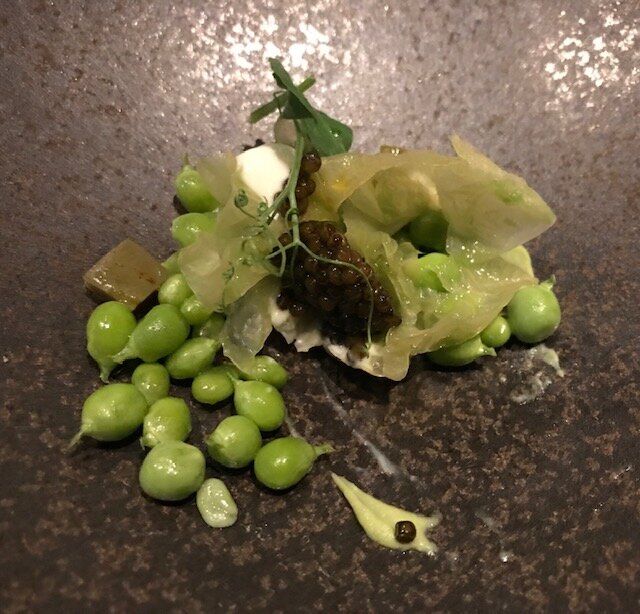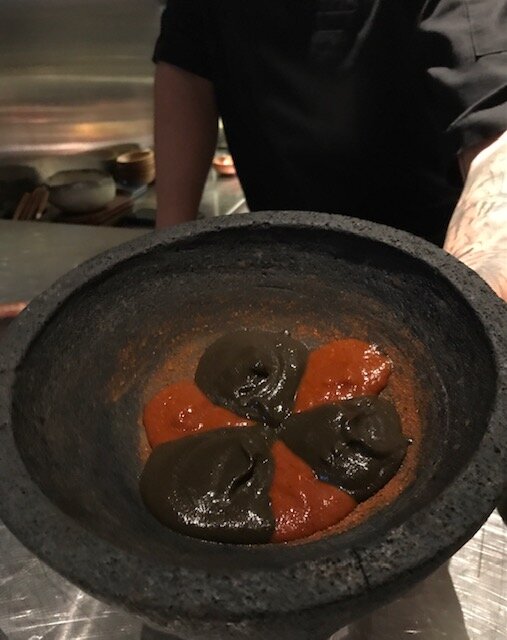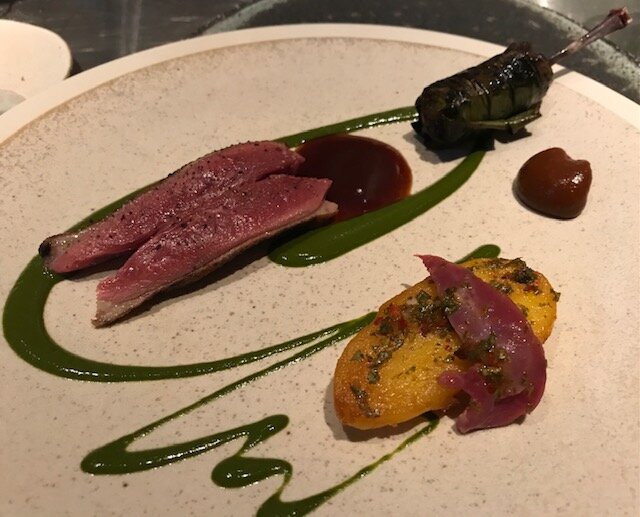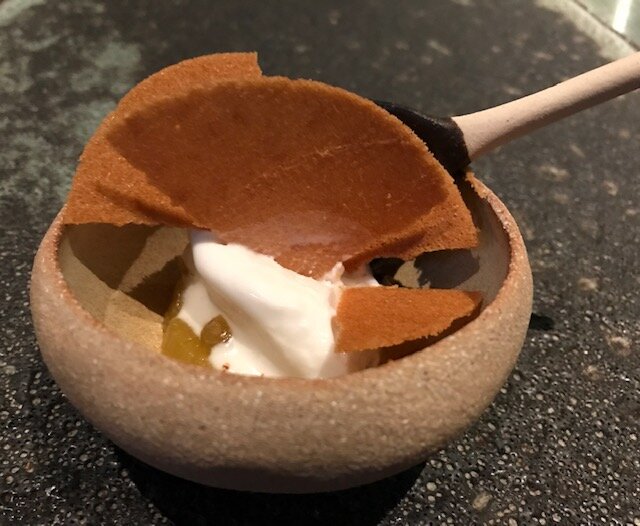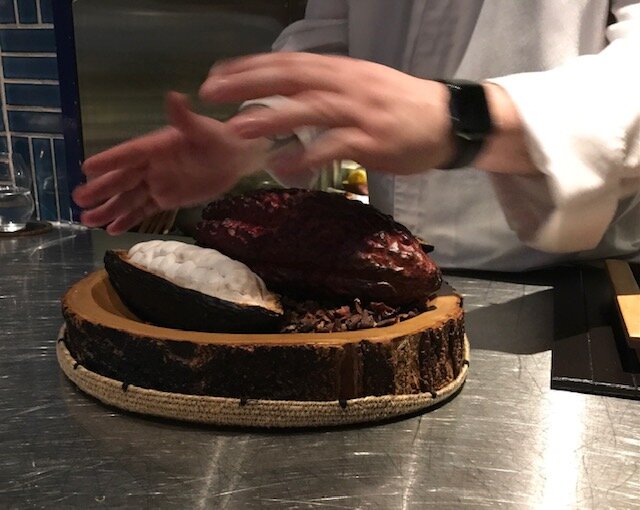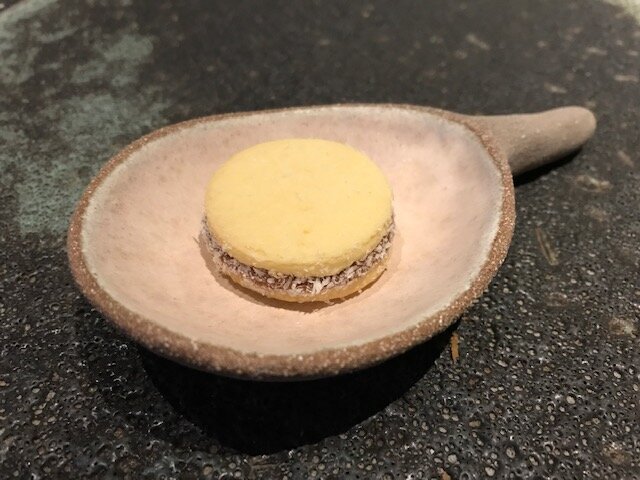April 30, 2021
You enter Mono from its own elevator landing. The room is masculine, dressed sharp. Your wife surveys it with admiration. ZZ Top: 'Cause every girl crazy 'bout a sharp-dressed man’. Mellow vinyl plays on a turntable. You and your wife are seated Royal Circle at a starkly beautiful stainless-steel counter overlooking a brightly lit kitchen. The focused chefs within -- including their skipper, Chef Ricardo Chaneton, formerly of the three-starred Mirazur in France -- command your attention.
A tasting menu is the only option. The style is French-Latin American, French technique applied to a number of flavors more common to Latin America.
Excellent champagne – Charles Dufour, Bulles de Comptoir, #8 Stillleben -- is poured into crystal so thin it seems wafted from a bubble wand. It aptly pairs with your first course of Hokkaido sea urchin and Brittany razor clam ceviche elegantly garnished with marigold leaf and puffed amaranth seeds (gratifying dots of texture). The dish is visually elegant like a brooch. At first bite, your tastebuds reel. Your eyes widen. Circuit breakers pop to save you from permanent damage. Extraordinary. The flavors and textures of the sea urchin and razor clam are each accurate and distinct and yet, bound by the lemony sauce, one. Mono leaps from the gate. It takes a lot of juice to maintain lift. Can they keep it up?
You see each dish being prepared which makes you feel connected to the food. Each is served personally by the chefs in artful ceramic which makes you feel connected to the kitchen. Gamba Rojas, Jicama, and Rocoto. The Mediterranean shrimp are raw, firm, flavor-true in a sauce of Chantilly cream tinted by vinegar and shallot (a creamy mignonette). There’s a gelee made from prawn-head bouillon that pumps in yet more flavor. Though they were flash-frozen, the shrimp taste like those you get in high-end sushi bars severed from life only moments before serving. There are small crunches of jicama. Were the Mediterranean condensed into one dish, this would be it.
Generally not a fan of orange wines which are often blunt with tannins, they serve an Italian Selvadolce VB1 vintage 2017, Terrazze dell’Imperiese Bianco. You know superlatives grow tiresome (a danger with this review that requires so many) so you hesitate to say more. Still, it’s crazy scrumptious, wine to make you howl, speak in tongues, scamper about on all fours. Like love, you must experience it to understand.
Tasting the raw peas in Green Peas, Imperial Caviar, Nopal you half expect they will rapture, fly upward to heaven, they are that good served in a lime vinaigrette. Shelled before you, they specifically cull the runts of the litter, tiny, radically sweet, lush with flavor. It shows the importance of meticulously curated ingredients. There are dabs of burrata cream and nopal (cactus). You think the bland nopal does nothing for the dish. Salty Chinese caviar is an exciting contrast.
You once ordered French fries in a restaurant. With sick fascination, you and your wife watched the chef tiptoe to a restaurant next door (like a cartoon thief) to get them, skulk back into his own kitchen with the fries hidden behind his back (like a cartoon thief), and triumphantly emerge with them moments later on a plate. They were cold. He hadn’t bothered to reheat them. You visited a HK restaurant recently that served canned cocktails instead of making them fresh. You’ll have no truck with this if you can help it. So you like a restaurant that makes its own bread (instead of tiptoeing to the bakery). Mono serves freshly baked sourdough quinoa bread, piping hot from the oven. As bubbles sparkle water, quinoa sparkles this bread, giving it the most delightful pops and crunches. There’s a distinctively floral olive oil – Eva Aguilera, picked (God’s honest truth) at the full moon for maximum flavor -- for dipping which your wife rhapsodizes about days later. How they get werewolves, notoriously feral, to pick the olives is beyond you.
Blue Lobster, Kari Gosse (a French curry powder that can only be purchased in French pharmacies), and Chayote takes lobster further than you knew it could go. This is because of the sauce of reduced lobster stock made from lobster heads plus a sprinkle of the Kari Gosse. It augments but doesn’t overshadow the lobster itself. Also, unlike all other lobster you have eaten, it is cooked au point. Previously you have filled yourself on brunch lobsters where this wasn’t a consideration. Give or take ten minutes in the bath, what’s the diff? This lobster is distinctly tender and full-flavored. The chayote is so mild you wonder if it adds anything.
It is no surprise to you that the asparagus in Pertuis Asparagus, Caribbean Sauce, Smoked Sardines is cooked perfectly, bright with flavor. Imported from Provence, it is beautiful, peeled in a helical pattern. The Caribbean Sauce features lemongrass and tamarind. As mathematicians perceive elusive relationships between numbers, Chef Chaneton perceives elusive relationships between foods. You would not have believed that smoked sardine could go with asparagus. Or trout roe (marinated in aged Nicaraguan rum). But they do.
Brittany Monkfish, Mate Béarnaise, Infladita (fried, puffed tortilla). You appreciate how they bring the monkfish for you to behold in its entirety (rubbed with cumin and chili) before they serve you a portion. The fish is dry-aged on the bone for 4 – 5 days to concentrate its flavor.
You know that some cutting-edge sushi bars serve aged fish and some cutting-edge bakeries bake with aged flour. Of course, beef is routinely aged. This is your first acquaintance with this technique applied to fish. The monkfish is meaty, mild, pristine, delightfully foiled by the Béarnaise. You would have enjoyed the Béarnaise even more had it been made with traditional tarragon and a drop more vinegar. To be truthful, you’re not charmed by the taste of mate, clearly an acquired taste. The fish is served two ways, as a filet, and within a puffed tortilla to be chomped in one bite. You both adore both.
Catalan red wine, La Cazotte, Domaine Petzold, Vin Catalan, 2015. It is big, operatic, bold enough to partner the next dish, Racan Pigeon, Ratte potato, 21 Ingredient Mole.
You relish pigeon. It is hard to cook right though. Usually it is overdone which brings out an off-putting liverish quality. Or it’s tough. Or sinewy. Ideally it’s served rare or just between rare and medium rare. With nonchalant ease, Mono cooks it perfectly. The leg is stuffed with pigeon mousse and a bunch of other good stuff (including capers and Venezuelan chilis), wrapped in banana leaf, steamed, then grilled over Thai charcoal. (Your wife says the leg was so yum, she wanted a whole plateful.) After charcoal-grilling the entire bird, you watch a chef filet the breast. Leg and breast (and a nutty slice of Ratte potato) are served with a dollop of pigeon jus and a trifecta of sauces. Guava ketchup and Chimichurri made with parsley and fresh oregano. Dazzling. Then -- drum rolls and elephants and fireworks and crashing cymbals -- 21 Ingredient Mole. It actually outranks the moles you’ve had from the dirt-floored mole markets of Oaxaca (which are the font of all mole). It contains too many ingredients to list. But they include dark Venezuelan chocolate, active charcoal powder, eggplant, and many kinds of peppers. They dramatically finish it before your eyes in a molcajete carved from volcanic stone which they hit with a blowtorch so when spices are added, their fragrances release.
Fresh lime zest is grated over. It’s deep and sweet and chocolate and somber and spicy and smoky and zingy. The entire dish, including the mole itself, is a triumph. Bravo!
You have on a few occasions in your life seen sights so beautiful that it hurts. A puppy gnawing on an expensive shoe and looking up with wide-eyed innocence. Your wife super-glammed for a date, a stray curl at the nape of her neck. Moonrise. The green flash. A crackling goose from the oven. So it is taste-wise with your final wine, Noe Vinum Optimum Rare Signatum Sherry 30 Years Old. Old, yet spry, sipping it is like a conversation with a beloved elder, profound, moving, beautiful. A hint of raisin, this is wine to contemplate, to cherish. You tip your Stetson to the sommelier (and restaurant manager), Mauricio Rodriguez. He’s a grape gunslinger. A deadeye.
Your first “pre-dessert,” served personally by Pastry Chef Dafne Herrada, is a riff on pina coladas: fresh coconut milk ice cream (from coconut milk freshly made in a Kennedy Town shop) with fresh pineapple and a condiment of habanero, yuzu, and Nicaraguan rum, beneath a coconut tuile. Delicious.
To compel nothing less than your total worship, Mono makes its own in-house chocolate from cacao beans they extract from cacao pods, something you’ve never before heard of in any restaurant. It would be like a race-car team making its own gasoline from crude oil they pump out of the ground or mining its own ore to make the engine’s metal. They show you the cacao pods with pulpy beans inside. Both the pods and the beans look sinister, like alien pupae soon to hatch out and unleash Armageddon. They give you a bean to taste in order to contrast it with the finished product which has undergone fermentation and processing. The pulp is citrusy with zero taste of chocolate, no imaginable connection. What genius it must have taken to first make this linkage.
Pastry Chef Herrada’s second dessert is based on this chocolate. A dribble of Sicilian olive oil on top of rosemary ice cream on top of chocolate ganache (so luscious it makes you pant), covered by a decorative chocolate net. There are ornamental points on the net made from glycerin-thickened olive oil. Beyond awesome. Staggering.
Your final dessert is a memorable dulce de leche cookie.
You coast to a stop with an excellent cappuccino.
Every time a microscope flips to higher magnification, complex features previously invisible become clear. Progressive layers of complexity underlie everything. Serious chefs understand this, layering complexity to create food that seems simple enough. For instance, you’d be forgiven for thinking Mono’s mole is straightforward, just chocolate and stuff whipped together like pudding mix, when really it’s advanced chemistry. Most customers couldn’t begin to fathom all that goes into Mono’s pigeon legs, at least ten ingredients and two cooking methods. Chefs who stack complex layers can go astray though, putting means over end. They so utterly fixate on the intricate process of fabrication that they lose sight of why they’re going to such trouble. Their food tends to be more fussy than delicious. Chef Ricardo Chaneton gets it. He single-mindedly crafts his cuisine from myriad bits combined in myriad ways to one end: ravishing food. All his experience, work, artistry, intelligence is bent to this paramount purpose. Thus Mono’s grilled pigeon leg. Thus their mole. Thus their housemade chocolate. Thus their ceviche. Thus the whole scrumptabulous shooting match.
You think that the chayote, the nopal, the mate were superfluous. Could they be there more to brand the food as Latin American then uplift it?
You’re astonished this restaurant doesn’t have at least one Michelin star. You can’t think why. It’s unquestionably as good as or better than other HK one-stars. All aspects of the dining experience surpass excellent. Perhaps Covid has kept Michelin inspectors away.
As some bag trophy game, others bag high-end restaurants. You know of none more worth bagging than Mono. A restaurant like Mono though really is particularly suited for those who know, who can flip the lens on their microscope to higher magnifications and appreciate the virtuoso command of tremendous complexity that informs each dish.
Mono leaps from the gate. It takes a lot of juice to maintain lift. Can they keep it up? Oh yes.
Rating (on a scale of 0 to 5)
Food overall: 5
Ambience: 5
Service: 5
Overall greatness: 5
Restaurants are intuitively rated within their particular realms. So Michelin restaurants, pizza places and stand-up sandwich joints are judged against like restaurants, not each other. A 5 for a high-end restaurant is not meant to be the same as a 5 for street food.
From my website, here’s how I rate food: “I believe the quality of a restaurant’s food is vastly more important than any other factor. Even if I love a restaurant’s food, I’m very conservative about giving out 4’s or 5’s. I reserve 4’s for food that is uniformly excellent. Preponderantly excellent tends to get a lower score. 5’s are for food that is stunning.”
This meal was comped. It cost HK$1488 each. The four-glass wine option was HK$888 each. There was a 10% service charge.
Mono
5/F, 18 On Lan
St, Central, Hong Kong
+852 9726 9301


